January 25, 2008
Air Date: January 25, 2008
FULL SHOW
SEGMENTS
Black Voters, Green Issues
/ Jeff YoungView the page for this story
Race is starting to play a role in the Democratic race for the White House. What environmental issues are most important to African American voters? Living on Earth's Jeff Young found South Carolina voters concerned about the toxic waste that plagues so many black neighborhoods. (08:00)
Focus the Nation
View the page for this story
Over 1500 college and high school campuses will take part in the largest teach-in in U.S. history at the end of the month. The "Focus the Nation" teach-in will create an open dialogue between students, civic leaders and policy makers on the issue of climate change. Students David Solheim of the University of Nebraska-Lincoln and Lacey Riddle of the University of Portland in Oregon tell host Bruce Gellerman about their schools' plans for the big day. (04:00)
Population versus Consumption
View the page for this story
We often blame rising population for the depletion of natural resources, but Pulitzer Prize-winning author Jared Diamond tells host Bruce Gellerman that we should really be more concerned about increased rates of consumption, especially in affluent Western societies. (10:00)
Power to the People
View the page for this story
The new campaign "Power to the People" aims to convince states to adopt legislation that would decentralize the nation's power grid and allow individuals to profit from creating their own renewable energy. Lois Barber, executive director of the EarthAction Network, gives host Bruce Gellerman the details. (05:45)
The Language of Landscape
/ Eva SaulitisView the page for this story
Living on Earth continues its series exploring features of the American landscape. The feature is based on the book "Home Ground: Language for an American Landscape," edited by Barry Lopez and Debra Gwartney. In this installment, Eva Saulitis reads her definition of “frost line”. (02:25)
South Africa Shark Spotters
/ Terry FitzPatrickView the page for this story
Great white sharks are found throughout the world, prompting many beach communities to set up special nets to protect swimmers and surfers. But Cape Town, South Africa is taking a different approach- they’ve set up a system of shark spotters who are on the lookout and sound an alarm when danger lurks in the water. Terry FitzPatrick explains how it works. (05:45)
Big Screen Science
View the page for this story
How accurate is the science in Hollywood’s sci-fi movies? Author and scientist Sidney Perkowitz opens the curtain on Hollywood science, starting with the birth of movies in at the beginning of the 20th Century. to today’s glitzy sci-fi thrillers. Perkowitz, the author of “Hollywood Science: Movies, Science and the End of the World” speaks with host Bruce Gellerman. (09:30)
This week's EarthEar selection
listen /
download
A troop of baboons in southeastern Zimbabwe.
Show Credits and Funders
Show Transcript
HOST: Bruce Gellerman
GUESTS: Lonnie Randolph, Jr., Joe Neal, Harold Mitchell, Norris McDonald, David Solheim, Lacey Riddle
REPORTERS: Jeff Young, Terry Fitzpatrick
[THEME]
From Public Radio International - this is Living on Earth.
[THEME]
I’m Bruce Gellerman. It’s the environment stupid, and too often, it’s a black and white issue.
RANDOLPH: Unfortunately the vast majority of those dumps are in African American neighborhoods, so environmental racism is alive and doing quite well here in South Carolina.
GELLERMAN: Coming up, politics and pollution - black voters and green issues. Also consumer spending may save our economy from recession, but could it destroy the planet in the process? Consumption of resources is the significant consideration in whether we’re going to have enough resources, population alone is only part of the equation.
And just when you thought it was safe to go back into the water - spotting sharks - this week on Living on Earth. Stick around!
ANNOUNCER: Support for Living on Earth comes from the National Science Foundation and Stonyfield Farm.
Black Voters, Green Issues
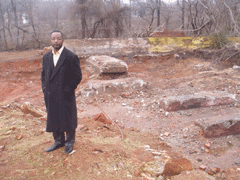
(Photo: Jeff Young)
GELLERMAN: From the Jennifer and Ted Stanley Studios in Somerville, Massachusetts - this is Living on Earth. I’m Bruce Gellerman, in for Steve Curwood.
South Carolina plays a pivotal role in presidential politics, and not just for candidates. It’s also an opportunity for African Americans, who make up half the voters in the state’s democratic primary, to have their issues heard. One of their major concerns is the environment. We sent Living on Earth’ s Jeff Young to South Carolina to talk green issues with black voters.
[ CHILDREN’S CHOIR SINGING: “I have decided to follow Jesus…”(FADES UNDER)]
YOUNG: If you want a quick check of the political pulse in African American communities, put on your Sunday best and get to the churchouse. At Friendship Baptist, in Columbia, Reverend Anthony Dicks told his church they wouldn’t just hear his sermon, they’d hear speakers from the Clinton and Obama campaigns.
DICKS (speaking from pulpit): It has been a long tradition in the African American culture. It’s critical my brothers and sisters, it’s critical.
YOUNG: Just across town at Zion Baptist, John Edwards attended a Martin Luther King Day ceremony.
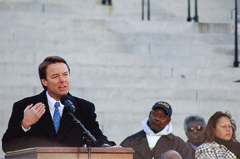
John Edwards (D-NC) at NAACP Martin Luther King Day on the Dome in Columbia, SC (Photo: Flickr/Justin Shearer)
YOUNG: All over South Carolina, politics found a place in the pulpit. And it was a good chance to ask churchgoers about the environmental issues on their minds.
Emily Washington and Bob McIntyre say green energy and global warming are important.
WASHINGTON: Absolutely it’s the life of the planet, so it’s top tier.
MCINTYRE: Personally I’m interested in oil and what they can do to change our dependency on it. Because I feel we have the resources here they’re just not being used.
YOUNG: That’s not so different from what you might hear from any demographic group. Polls show people across the board are concerned about the changing climate and soaring energy costs. But Shirley McClary of Columbia zeroed in on an issue she thinks is of particular interest to African American voters.
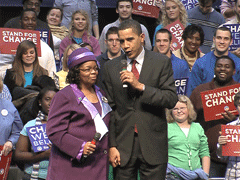
In this photo, Senator Barack Obama rallies in Greenwood, South Carolina. Sen. Obama won the endorsement of South Carolina lawmaker Joe Neal. Neal says tackling environmental justice issues means being able "to build consensus, and I think Obama is able to do that." (Photo: Flickr/Barack Obama)
MCCLARY: Well, all this dumping that they’re doing now in South Carolina, that is very much a concern of ours because we’re the ones living there and our children is the one being affected by this.
YOUNG: South Carolina NAACP conference president Lonnie Randolph, Jr., says this notion of environmental justice could be a strong motivator for black voters.
RANDOLPH: Of course it is, it’s a quality of life issue. Environmental issues produce health problems. This is one of the worst states in the nation as it pertains to the health of African Americans. And unfortunately the vast majority of those dumps are in African American neighborhoods, so environmental racism is alive and doing quite well here in South Carolina.
YOUNG: Democratic state representative Joe Neal sees that first hand. His rural, largely African American district on the outskirts of Columbia has to deal with mercury in the rivers, nuclear waste and contaminated groundwater.

Sen Hillary Clinton, at NAACP Martin Luther King Day on the Dome in Columbia, SC. "Hillary Clinton is leading the way" on environmental justice issues, says Norris McDonald of the African American Environmentalist Assoc. (Photo: Flickr/Justin Shearer)
NEAL: We have a superfund site, uh, happens to be right across the street from the nuclear fuel reprocessing plant. And when you talk about South Carolina as a whole, the state has 24 superfund sites. 23 of them are in African American communities. So, what we find in this state, I think is pretty typical for the country. Pollution and waste tends to follow the path of least resistance.
YOUNG: Do people suffering the brunt of that, do they connect that to something they should vote on?
NEAL: Well, often they do. I think that many will make the decision as to who they will vote for not explicitly on the basis of their own situation, but on the larger sense of fairness and justice in all policies, and particularly in environmental policy.
YOUNG: The endorsement of an African American state lawmaker is highly coveted in this highly competitive state. Neal was considering Barack Obama and one other candidate.
NEAL: I also like John Edwards and his emphasis on everyday working people, and fairness and justice. But I think Senator Edwards has a… he comes into politics as a trial attorney and he’s used to fighting. Politics is a little different here. We need to be able to build consensus, and I think that Obama is able to do that. And that’s why I chose him.
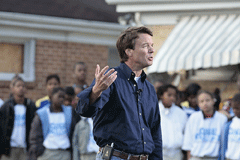
Former North Carolina Senator John Edwards wins kudos from environmental justice activists for his focus on poverty. He launched his presidential campaign from the Lower Ninth Ward of New Orleans.
(Photo: (c) Rachel Feierman)
MITCHELL: (walking while talking) This is where, as you can see, a lot of the debris that was uncovered. 1500 tons of coal ash debris and hazardous materials was removed from the site.
YOUNG: The Arkwright neighborhood of Spartanburg also has two superfund cleanup sites: an old fertilizer plant and a closed city landfill, all side by side in a black neighborhood.
MITCHELL: On this side of town folks back then thought that it was an area where that’s where they considered the people as nobody. So that’s where that landfill is located, and you can see all of the industrial facilities were located right fence line to the neighboring community.
YOUNG: But those nobodies, in this case, that was you and your family?
MITCHELL: Yes. You could look out my window as a child and I could see the landfill. My sister, she died of acepsyssomphilitis—germ poisoning—and my father, he died of lymphoma. And we ain’t…I mean throughout the community it’s like every other house, or every house. Then you start to see a pattern of problems there.

Barack Obama (D-Ill) at NAACP Martin Luther King Day on the Dome in Columbia, SC (Photo: Flickr/Justin Shearer)
CLINTON (speaking at opening of hearing): Today’s hearing represents the first senate hearing in history devoted to environmental justice.
[CROSSFADE INTO MITCHELL]
MITCHELL: You know, sitting in that hearing, Senator Clinton put it in perspective so well. She was able to capsulize it and look at solutions, and you would need just that, someone that can listen, and as she stated during this campaign, someone who can actually manage the change.

"You could look out my bedroom window as a child and see the landfill." South Carolina lawmaker Harold Mitchell grew up near this and two other toxic sites. Of the 24 Superfund cleanup sites in the state, 23 are in black neighborhoods. (Photo: Jeff Young)
MCDONALD: Well Hillary Clinton I would have to say on environmental justice is probably leading the way addressing that issue.
YOUNG: Are you surprised Senator Obama has not shown more leadership on this issue at all?
MCDONALD: It’s not puzzling at all. He’s appealing to the white vote. And if he is perceived as being black, and when I say that I mean Jesse Jackson or Al Sharpton, complaining about racial issues. It makes whites uncomfortable. And I can understand his not wanting to be pigeon holed quote as the ‘black’ candidate, but it has negative consequences, when then he can’t address substantive issues, such as environmental justice.
YOUNG: McDonald says Clinton has advanced environmental justice through her policy and shrewdly positioned herself politically. She’s outflanked Obama on an issue that could prove potent to African Americans around the country who would make environmental justice part of their voting decision.
For Living on Earth, I’m Jeff Young in Columbia, South Carolina.
Related links:
- African American Environmentalist Association blog
- The ReGenesis Project in Spartanburg, SC
- View or read testimony at the US Senate's first-ever hearing on environmental justice
- LOE's complete election coverage
[MUSIC: The Uptown String Quartet “Blues March” from Just Wait a Minute (Max Roach Production Inc. 1992)]
Focus the Nation
GELLERMAN: Students nationwide say global warming is making them hot as hell and they're not going to take it any longer. At the end of this month in a demonstration reminiscent of the 1960's, they'll be conducting what organizers say will be the largest teach-in in history - involving millions of students on over 1500 college campuses and high schools.
The teach-in is just one in a number of events, part of "Focus the Nation" - global warming solutions for America. David Solheim is President of the Student Body at the University of Nebraska- Lincoln. Also joining us from the University of Portland in Oregon is Lacey Riddle. Hello both. David, let's start with you. What are you guys doing there?
SOLHEIM: Well at the University of Nebraska, Lincoln, it’s really something exciting and unprecedented. We’ve got about 12 lectures lined up from professors from a variety of disciplines. We’re trying to show the pervasiveness of climate change and how that affects each area of campus, not just the sciences. In addition we have a low carbon footprint meal and an example of a sustainable dorm room set up on campus as well.
GELLERMAN: A sustainable dorm room? I think many parents would just settle for a clean dorm room but what’s a sustainable dorm room?
SOLHEIM: Well a sustainable dorm room what we set up with all the standard furniture, which comes in any dorm room on campus. But all of the consumer products within that dorm room will be sustainable products that we’ve had donated from different businesses around Lincoln. And so we have an organization on campus called the “Green Builders” who are putting that together. Just showing students that even though you’re away at college and stuffed away in a little box on the tenth floor, you can still contribute in a big way to climate change.
GELLERMAN: And Lacey, what are you going to do at the University of Portland?
RIDDLE: Well, we’ve actually got two major events going on. During our daylong teach-in, it’s the same thing kind of as the University of Nebraska. We’ve got about 26 panel sessions where teachers from all disciplines will sit down together and really encourage their students to either not attend class and attend to these panel sessions that are relevant to their classes, or if they can’t, you know, sacrifice one day they’ll sit down and discuss the issue in class for at least a few minutes and then come five o’clock we’ll all convert over to the child center and really warm up with some live sketch comedy that’s climate change themed. And then we’ll also have local band “Hillstop” who plays on half recycled instruments play.

Lacey Riddle of the University of Portland (Courtesy of Lacey Riddle)
RIDDLE: Well, I don’t know if either of you read Thomas Friedman’s “Generation Q” but apparently we are Generation Quiet and that is kind of evident as you know, as we are the Facebook generation, we live our lives online. But I think we’re realizing, you know, just saying that you’re doing something online and actually doing something in person won’t invoke our older generations. It won’t really address the issues and make them concerned about our future. So, I think we’re kind of stepping out of the box and realizing our place in society and really addressing our own civic responsibilities and now you’re seeing, I think, activism flourishing at universities.
SOLHEIM: Yeah, I think that’s exactly right. The Tom Friedman article was I think inflammatory to young people who are trying to be active all across the nation and it really forced us to kind of face what I believe is an evolution in activism. I think that our generation is more service-oriented than any before us but we want to encourage that traditional aspect of activism too, which is writing letters and being vocal and showing up at the ballot box to really effect change here.
RIDDLE: I think there is a huge, huge, huge need to raise awareness amongst our political leaders. They are the people who determine our future. It’s their legislation that will change my generation’s future and prepare us for transitioning into a clean energy economy.
SOLHEIM: I’ve always urged our students to look at the candidates, look at their stances on issues, and make climate change one of those deciding factors in who you cast your ballot for in November.
GELLERMAN: Well, David, Lacey, thank you both very much. Good luck with Focus the Nation.
RIDDLE: Thanks so much, Bruce.
SOLHEIM: Thank you much. We appreciate it.
Related link:
Focus the Nation
[MUSIC: j. mascis “a little ethnic song” from “guitarrorists” (no. 6 records 1991)]
GELLERMAN: Coming up—people power to power people. Stay tuned to Living on Earth.
[MUSIC: Andres Segovia “Recuerdos de la Alhambra” from “The Art of Segovia” (Deutsche Grammophone GmbH, Hamburg 2002)]
Population versus Consumption
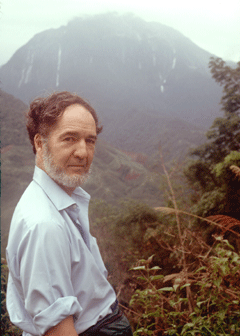
Pulitzer Prize-winning author Dr. Jared Diamond (Photo: University of California at Los Angeles)
GELLERMAN: It’s Living on Earth, I’m Bruce Gellerman. So steep and deep was the recent slide on the world’s stock markets that politicians began uttering the dreaded ‘r’ word. To stave off a recession or even worse, the Feds lowered a key interest rate, calling on Americans to do what Americans do best: consume. Save the world’s economy by generating demand for stuff. But Jared Diamond, in a recent New York Times op-ed, warns that our current consumption isn’t saving the planet, it’s destroying it.
Jared Diamond is a professor of geography at UCLA and best-selling author of Collapsed and Guns, Germs, and Steel. I called Professor Diamond at his home in Bel Air, California, and asked him why he’s focusing on consumption when others say the real problem is the world’s rapidly growing population.
DIAMOND: I’m looking at consumption as opposed to population because consumption of resources is the significant consideration in whether we’re going to have enough resources. Population alone is only part of the equation. What counts is the number of people times how much, on the average, each of those people consume. And that means that consumption rates rise—either if population rises which it’s doing slowly—or per person consumption rates rise, which they’re doing rapidly as a result of China and India catching up and as a result of people from all over the word doing their best to try to move to the U.S., and Europe, and Australia and become first world consumers.
GELLERMAN: In your article, basically you say that the world population has six point five billion people—that it will have nine billion people by mid-century. But if we all consumed like Americans that the rest of the world would add up to 72 billion people.
DIAMOND: Americans and other first worlders—that’s to say Europeans and Japanese and Australians—consume 32 times more resources. That’s to say we consume 32 times more gas, and 32 times more metals, but by the same token we put out 32 times more waste like plastics and greenhouse gases, than do citizens of third world countries, and that means that one American equals 32 Kenyans in his or her impact on the rest of the world.
GELLERMAN: So as long as Kenyans consume like Kenyans do now, we don’t have anything to worry about in terms of the resources that we need and utilize.
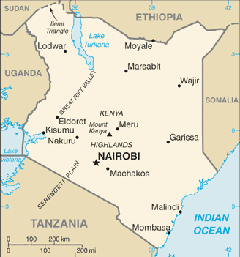
The average American consumes 32 times more resources than the average Kenyan. (Photo: CIA)
GELLERMAN: So in terms of just growth, basically we have a small population growth here in the United States, a declining population growth in some places—in Europe—but in developing countries, they really do have explosive population growths.
DIAMOND: That is true and it’s not the biggest problem. It is true that countries like Kenya and Pakistan and some other developing countries have high population growth rates. And that is a real tragedy for Kenya and Pakistan, which are trying to improve their lot but are getting overwhelmed with more people to feed. But it’s not a tragedy for the rest of the world because those people in rapidly growing third world countries don’t consume very much. The real tragedy for the world is the growth rate of population and consumption in the first world. Now you’re correct that the homegrown population of Japan and Europe is actually shrinking, but that’s more than offset by all those immigrants pouring into Europe and the United States and increasingly even Japan as a result of third world people who just can’t wait for Kenya to achieve first world living standards, but want those living standards now. And as a result they move across the Mediterranean into Europe and they move across the border into the United States and they become first world consumers.

Pulitzer Prize-winning author Dr. Jared Diamond (Photo: University of California at Los Angeles)
DIAMOND: One of the biggest economic facts of all time is that China’s being very successful in catching up with the first world. China’s goal is to achieve first world living standards, which means to consume the way we are consuming now. Well, if China alone catches up to the first world and nothing in the world changes, that doubles consumption of the whole world. If India and China catch up, that triples consumption of the whole world regardless of what happens in Africa and South America.
GELLERMAN: The way we live right now—do we have a vested interest in the continuing poverty of places and so many people around the world?
DIAMOND: You might say that we have a short-term, short-sighted vested interest. It’s the vested interest of an ostrich, with its head buried firmly in the sand, as the lion creeps up behind it. The ostrich has a vested interest in not seeing the lion, because that means the ostrich will be happy for the next three seconds until the lion springs. Yes, the United States has a vested interest in ignoring the problems of the rest of the world. But we can’t ignore those problems. We’ve known ever since September 11, 2001, that the rest of the world now has ways of sharing their unhappiness with us if they do feel unhappy. So it’s just not possible for us to ignore the rest of the world.
GELLERMAN: So what country do you think we should emulate?
DIAMOND: First of all, we should emulate ourselves in certain respects. Let’s not just bash the United States. The United States in the last 30 years has done very well in dealing with problems of air quality. We now have federal standards and state and city standards for air quality and the result is that although there are lots more people and far more cars in Los Angeles than there were when I moved here in 1966, air quality is better. Other countries that we can emulate are European countries in their energy consumption. Or even the Asian—the Himalayan country of Bhutan—that small, rather poor, Asian country whose king has proclaimed that their goal is not to maximize the gross national product. Bhutan’s goal instead is to maximize gross national happiness. And that’s really what it’s about for us, too.
GELLERMAN: So, if we consumed like the Europeans, we wouldn’t necessarily have a decrease in our standard of living, even though our consumption would go down.
DIAMOND: If you look at Europe, we would have an increase in our standard of living if we decreased our consumption rates. Just think of Europe’s standard of living. Just think of what really counts in standard of living. Standard of living is not a matter of jumping into your Humvee and roaring off with your one person in your Humvee down the freeway. Standard of living is access to medical care, quality of public schools, support for the arts, whether you’ve got a pension in your old age, by any of those measures, the standard of living in Europe is a little higher than that in the United States, even though Europe’s consumption rates are lower. What this means is that it’s perfectly possible to cut all consumption even while raising our standard of living. The reason is simply that a lot of our consumption is just wasteful and doesn’t contribute to our standard of living. Owning a Hummer or an SUV does not increase your lifespan or increase your access to medical care.
GELLERMAN: So professor, how would you get Americans to consume less?
DIAMOND: My contribution to getting Americans to consume less is to do interviews with you and to write books and to write Op-Ed pieces. But Americans themselves are going to get themselves to consume less by confronting the reality of how the world is going and then acting in the best interest of themselves and their children. Dick Cheney, our vice president, attributed to him at least is a frequently quoted statement—and let’s see how it goes, it’s roughly like, ‘the American way of life is not open to negotiation.’ Yes, we are not going to negotiate the American way of life with Iran. But we are going to negotiate the American way of life with ourselves. We are the ones who are going to have to make these decisions.
GELLERMAN: Do you think it would take a dramatic makeover of the American economy in order to sustain a first world lifestyle but make it sustainable?
DIAMOND: It would take a slow continuation of the changes that we’ve already seen. For example, gas consumption. The price of gas here in L.A. is now up to three dollars and 80 cents and recently it may have topped four dollars, and it will undoubtedly go over four dollars soon. And let’s see what happens if the price of gas goes up to five or six dollars. In Europe the price of gas is the equivalent of eight or nine dollars. That’s part of the reason why Europeans tend to have gas efficient cars. So, four-dollar gasoline has already pushed lots of people into Priuses. I’m looking forward to six dollar and seven dollar gasoline.
GELLERMAN: I’ve got to tell you. I got a Prius.
DIAMOND: I am the proud owner of a Volvo. And my wife also has a Volvo. When and if our Volvos ever fail, we will either buy a Volvo hybrid—if by then Volvo has hybrids—or I will emulate you and buy a Prius.
GELLERMAN: But right now, you’ve got two Volvos. You’re part of the pollution, not part of the solution.
DIAMOND: I am part of the pollution. On the other hand, my defense is that I use my Volvos 3,000 miles a year to run around and do virtuous things.
GELLERMAN: Professor thanks a lot. I really appreciate it.
DIAMOND: You are welcome.
[MUSIC: Charlie Haden & Pat Metheny “Tears of Rain” from “beyond the Missouri Sky” (Polydor/PolyGram S.A. France 1997)]
GELLERMAN: Jared Diamond is a professor at UCLA and author of Collapsed, and Germs, Guns, and Steel.
Related links:
- UCLA Department of Geography: Jared Diamond
- Jared Diamond's New York Times Op-Ed
[MUSIC: John Lennon & The Plastic Ono Band “Power to the People” (Apple/EMI 1971)]
Power to the People
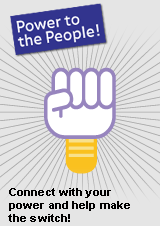
The Power to the People campaign stamp- modeled after and LED lightbulb. (Photo: EarthAction)
GELLERMAN: When John Lennon recorded this song back in 1971, it soon became an anthem for a generation.
[MUSIC: John Lennon & The Plastic Ono Band “Power to the People” (Apple/EMI 1971)]
GELLERMAN: But today a new generation is embracing the song's slogan and message.
[MUSIC: John Lennon & The Plastic Ono Band “Power to the People” (Apple/EMI 1971)]
GELLERMAN: They’re saying power to the people is an idea whose time has finally come and that climate change means time is running out. Power to the People is the name of a new collaborative campaign organized by the Earth Action Network and the World Future Council. The goal: to get states to adopt legislation to decentralize the nation's power supply.
Joining us from Amherst, Massachusetts is co-founder and Executive Director of Earth Action Network is Lois Barber. Lois, hi!
BARBER: Hi, it’s nice to be here.
GELLERMAN: Or should I say ‘right on.’ When I hear this song I kind of revert back to my roots.
BARBER: Right. So do I. One of our symbols for this campaign on our poster is a lightbulb in the shape of a fist, and it says power to the people. And I think it really talks about this transition of how now energy is where power is.
GELLERMAN: Well exactly what is it that you’re trying to do?
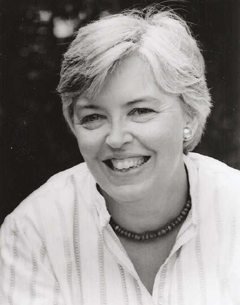
Lois Barber of EarthAction (Photo: EarthAction)
GELLERMAN: I was looking on the Earth Action webpage and there’s a link to your campaign, Power to the People. And the legislation that you want to introduce here is based upon legislation that first showed up in Europe, in Germany.
BARBER: Right. Germany, Denmark, Spain have all been leaders.
GELLERMAN: And what is that legislation specifically?
BARBER: Well it does three things. It requires utility companies to buy all the renewable energy that’s produced in their region. They can’t have favorites. They can’t, you know, just buy oil and coal and not buy renewable energy. Secondly, they have to pay a certain price for that renewable energy that’s set by a board. And thirdly they have to pay that price for a very specific number of years. Usually it’s fifteen to twenty years—a very decentralized model.
GELLERMAN: It’s called ‘feed in tariff.’ That’s a mouthful.
BARBER: It is. It was named this in Europe. The words really don’t have a lot of meaning here in the United States. They’re actually a little scary—tariff always makes me think of taxes. So tariff has a different meaning in Europe. But the idea of feed in comes from that individual producers can feed the electricity that they produce into the grid and get paid for it.
GELLERMAN: Has it been successful in Europe?
BARBER: Oh it’s been amazing. It’s made Germany the absolute number one leader in renewable energy worldwide. It’s created over two hundred and 30 thousand jobs in the renewable energy sector in Germany. It’s helped Germany meet its renewable energy goals of 12 percent of their renewable energy now comes from renewables, and they met those goals three years early. They’re now the number one exporter of solar panels and other renewable energy technology.

The Power to the People campaign stamp- modeled after and LED lightbulb. (Photo: EarthAction)
BARBER: (laughs) No. Although it’s not a bad idea. I just visited a yurt last weekend. It was charming. No, you know, and I really know about this issue from my personal life, too. In 1971 with a small group of people I went to northern British Columbia, Canada, as a sort of retreat from the industrialized world. And tried to live as simply and sustainably as possible. And one of the things we did was develop our own hydroelectric system off the creek that ran by our house. So I really got very personally familiar with what energy means. This isn’t a new idea, but it’s an idea that’s now necessary. I mean, in 1971 it was sort of a bit of a luxury to be able to go and be part of the back-to-the-land movement. But nowadays, it’s not an option. Everybody has to be part of this movement of switching from fossil fuels to renewable energy.
GELLERMAN: Now your campaign targets nine states, right? In the United States? One of those is Michigan. And they already have legislation pending that would accomplish many of your goals. Am I right?
BARBER: That’s right. Representative Kathleen Law—just as we were getting started with our campaign here we learned that she was a little bit ahead of us. She had already introduced a piece of legislation.
GELLERMAN: Lois, how likely do you think the American public is to embrace, not just the goals, but the means and the methods, to become, you know, basically energy independent of the big companies?
BARBER: Well I think the American people, once they learn about this type of legislation, are actually going to demand it from our government because it helps meet their needs. It’ll create jobs. You know every state that produces renewable energy will be able to keep the revenue from that renewable energy within their state to help meet state budgets.
GELLERMAN: Well, Lois, thank you very much.
BARBER: Well, your welcome. It’s been a pleasure to be here.
GELLERMAN: Lois Barber is the cofounder and executive director of Earth Action Network, which is collaborating with the World Future Council on the Power to the People campaign.
Related links:
- Power to the People
- EarthAction
- World Future Council
[MUSIC: John Lennon & The Plastic Ono Band “Power to the People” (Apple/EMI 1971)]
The Language of Landscape
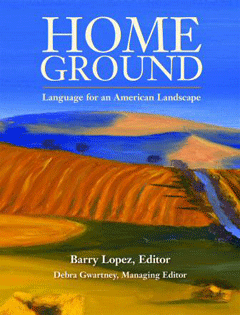
Home Ground: Language for an American Landscape, edited by Barry Lopez and Debra Gwartney. (Courtesy of Trinity University Press)
GELLERMAN: Now if somebody asked you what a frostline was, you might think Robert Frost, who had a lot of good lines: ‘Good fences make good neighbors’ or maybe ‘Whose woods these are I think I know.’ Frost had a great sense of the countryside around his New England home, and he might well have appreciated a book we’ve been featuring occasionally on Living on Earth. It’s called Home Ground: Language for an American Landscape. Barry Lopez and Debra Gwartney edited the book, choosing authors to define features of landscapes near and dear to them. Today, Eva Saulitis of Homer, Alaska defines frostline

Home Ground: Language for an American Landscape, edited by Barry Lopez and Debra Gwartney. (Courtesy of Trinity University Press)
GELLERMAN: Eve Saulitis is a writer, teacher and marine biologist from Homer, Alaska. Her definition of frostline appears in Home Ground: Language for an American Landscape, edited by Barry Lopez and Debra Gwartney.
Related link:
Home Ground: Language for an American Landscape
[MUSIC: Ulli “Angie” Ageless Guitar Solos (Waters Edge 1996)]
GELLERMAN: Coming up – the science underpinning the fiction - Stay tuned to Living on Earth.
[MUSIC: Adrienne Torf “learning to pray” from two hands open (ABongo Music 2003)]
South Africa Shark Spotters

Cape Town’s clean, temperate waters support seals, rays, dolphins, penguins, whales—and more than 250 great white sharks that prey on them. This is Cape Town as seen from Robben Island. (Photo: Terry FitzPatrick)
GELLERMAN: It’s Living on Earth, I’m Bruce Gellerman.
[MUSIC FROM “JAWS” THE MOVIE]
GELLERMAN: They’re out there, lurking in the deep, hungry, waiting.
[MUSIC FROM “JAWS” THE MOVIE]
GELLERMAN: Actually, sharks aren’t all that dangerous. According to the International Shark attack file, there were just 62 confirmed, unprovoked shark attacks on people in all of 2006. That very same year, 150 people were killed by falling coconuts.
Still, you don’t want to have a close encounter with a great white in the deep blue, so some beaches where sharks share the water with swimmers are trying out new ways to protect people. In Cape Town, South Africa they’ve created a network of ‘spotters’ who sound an alarm when danger lurks below.
Terry Fitzpatrick lived to tell our tale.
FITZPATRICK: If you’re swimming along Cape Town’s ocean beach, this is a sound you do not want to hear.
[THREE BLASTS OF HORN]
FITZPATRICK: This is just a test. But about 50 times a year this horn--and an even louder siren-- signal an actual alarm. It means a great white shark is swimming toward shore.

(Photo: Shark Spotters)
FITZPATRICK: Yvonne Kamp of the Cape Town shark spotter patrol says the warnings work.
KAMP: It really just takes a few minutes. That siren goes and everybody knows the drill. The shark spotters also walk up and down and blow whistle and wave hands, you know whatever it takes to get the last people out of the water.
[BEACH SOUND FADES DOWN MOUNTAIN ROAD SOUND FADES UP WITH WALKIE-TALKIE SOUND]
FITZPATRICK: The shark spotters are a team of 20 specially-trained lookouts, funded by the city of Cape Town, the World Wildlife Fund and local surf shops. Their work begins not on the beach, but in the mountains high above shoreline.

Cape Town’s clean, temperate waters support seals, rays, dolphins, penguins, whales—and more than 250 great white sharks that prey on them. This is Cape Town as seen from Robben Island. (Photo: Terry FitzPatrick)
FITZPATRICK: Here, Tracey Provins peers at the ocean using high-power binoculars.
PROVINS: Visibility is about ten percent. I’ve got about 20 surfers and ten bathers, copy.
FITZPATRICK: Provins says a great white shark is hard to miss. They can grow up to 20 feet long.
PROVINS: It’s a dark shadow. Most of the time, they don’t come up. If they come up, we’ll just see the fin.
FITZPATRICK: Provins uses a walkie-talkie radio to warn the beaches below. She tracks everything in the water because wherever there’s prey, predators follow.

From mountain lookouts, Shark Spotters peer at the coastline for tell-tale shadows or fins in the water below. (Photo: Shark Spotters)
FITZPATRICK: Great white sharks are a particular problem in Cape Town. At least 250 of them come to feed at a seal colony that lives on an island close to shore.
Marine biologist Alison Kock at the University of Cape Town has been using underwater radio beacons to study the sharks.
[TAPPING TRANSMITTERS]
FITZPATRICK: The beacons look like thick grey pencils with fish-hooks at the end.
[TAPPING TRANSMITTERS]
KOCK: And what we have here is an acoustic monitor. And what these do is they work in conjunction with a transmitter, which we tag the sharks with. So when we get up close and personal with the sharks, we try to attach these transmitters to them. And this transmitter sends out a unique code.

Shark Spotters fly flags and sound sirens at key beaches to warn swimmers and surfers about the presence of great white sharks. (Photo: Shark Spotters)
KOCK: White sharks are particularly confident, curious animals. They’re really interested in people. And for the most part they don’t do anything. They swim by, they have a look, they swim by, and they carry on swimming.
FITZPATRICK: But with more than 100 teeth, even a curious nibble from a great white can maim or kill a person. Cape Town’s shark spotter program began three years ago after a series of attacks. There were calls to cull the shark population. But great whites are an endangered species, and Kock says killing them would upset the region’s balance of marine wildlife.
KOCK: Great white sharks are the top predator in our waters here in Cape Town. So this means that they have a lot of influence on all the species below them. They not only prey on seals, they prey on different shark species, fish populations, rays — all kinds of things.
[MARINA COMPRESSOR SOUND FADES OUT, BEACH AMBIENCE FADES UP]
FITZPATRICK: Shark spotter Yvonne Kamp says safety nets were ruled out for Cape Town because sharks, dolphins, turtles, penguins and whales get tangled in them and die. She says her network of warning stations is a healthy compromise.

(Photo: Shark Spotters)
FITZPATRICK: Many surfers and swimmers support this approach.
WOMAN: People should leave the water first before taking out any sharks. You know, it’s their world and they should be left alone.
MAN: I think the sharks have just as much right to be in the water as we have, and they are entitled to be there.
WOMAN: I think if they wanted to attack people there would be more attacks, because there are a lot out there. So basically, you take your chances. (laughs)
[WALKIE-TALKIE CHATTER “Copy lookout? Copy. Copy Noordhoek? Copy. Okay guys, stand by.”]
FITZPATRICK: The shark spotting program does more than safeguard the beach. Yvonne Kamp says it increases awareness about the role sharks play in the marine ecosystem. And it provides jobs.
KAMP: The shark spotting program is primarily a safety program, but it's also creating opportunities for people, like the shark spotters. A lot of them of them were unemployed. So there’s a lot of other spin-offs from the program besides the safety of the people in the water.
[WALKIE-TALKIE CHATTER “I just need a situation, please give me your situation, please.”]
FITZPATRICK: The spotting team seems to be beating the odds. According to Shark Attack File, a group that tracks incidents worldwide, roughly 90 shark bites are reported each year. On average, six people are killed. But since the spotters began protecting ten popular beaches, they haven’t had a single shark attack.
[WALKIE-TALKIE CHATTER “Okay, can I get the situation please.”]
FITZPATRICK: For Living on Earth, I’m Terry Fitzpatrick in Cape Town.
[BEACH SOUND FADES OUT]
Related links:
- Shark Spotters website
- Global Shark Attack File
Big Screen Science
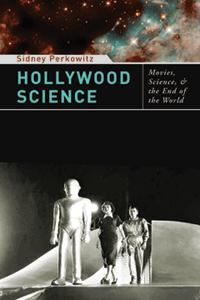
Hollywood Science: Movies, Science and the End of the World (Photo: Columbia University Press)
GELLERMAN: From Bruce the shark—to a close encounter of a different kind.
[E.T. SAYS ‘ET PHONE HOME’]
GELLERMAN: Extra terrestrials are extra popular on the big screen. In fact, a third of the top grossing movies are science fiction films. Think: Jurassic Park, The Invasion of the Body Snatchers, AI, Blade Runner, Spiderman… Sci Fi flicks feature flights of fantasy that can transport us beyond our imaginations, but not all the science in the movies measures up to the standards of Sidney Perkowitz. He’s a physicist at Emory University and author of the new book, “Hollywood Science: Movies, Science and the End of the World.” Professor Perkowitz, welcome to Living on Earth.
PERKOWITZ: My pleasure, Bruce. Thanks for having me.
GELLERMAN: Or should I say ‘Klaatu barada nikto’?
PERKOWITZ: Well, that would win you favor with a lot of science fiction fans, that’s for sure.
[SCENE FROM A MOVIE; WOMAN SAYS ‘KLAATU BARADA NIKTO’]
GELLERMAN: That’s from the 1951 classic “The Day the Earth Stood Still.” You have a picture of it right on your book.
[WOMAN REPEATING ‘KLAATU BARADA NIKTO’]
GELLERMAN: What does ‘Klaatu barada nikto’ mean?
PERKOWITZ: Apparently it’s instructions to the deadly robot Gort to do the right thing after his boss Klaatu has been shot down by the military.
GELLERMAN: Well, let’s listen to some of “The Day the Earth Stood Still.” This is the original:
[BROADCAST JOURNALIST ANNOUNCES ‘WE INTERRUPT THIS PROGRAM TO GIVE YOU THIS NEWS BULLETIN FROM ONE OF OUR NAVAL UNITS AT SEA. A LARGE OBJECT TRAVELLING AT SUPERSONIC SPEED IS HEADED OVER THE NORTH ATLANTIC TOWARD THE EAST COAST OF THE UNITED STATES’ - SIRENS WAIL]
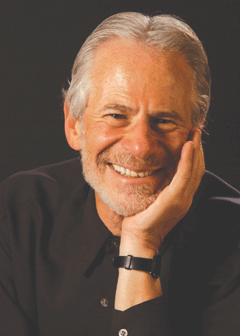
Sidney Perkowitz (Photo: Columbia University Press)
PERKOWITZ: At the time, which was the 50’s—and we have to cast our minds back to what that meant. We were in the middle of the Cold War and it was just a few years after an atomic bomb had first been exploded. So this is a movie that has some science in it—or pseudo science—but really it has a message: be very careful with nuclear weapons. And that makes it a classic because of the message it carries but also because it’s a good, tightly constructed movie.
[SCENE FROM A MOVIE, MALE VOICE: ‘I CAME HERE TO GIVE YOU THESE FACTS, BUT IF YOU’RE CERTAIN TO EXTEND YOUR VIOLENCE, THIS EARTH OF YOURS WILL BE REDUCED TO A BURNED OUT CINDER’]
GELLERMAN: Science fiction has been a huge part of the film industry from the—well, almost from the very beginning.
PERKOWITZ: I was surprised when I researched it. If you do the sums it turns out there’s been at least one major science fiction film made per month since 1902 and 1902 is not very long after movies began. So yes, it’s been a continuing thread for decades and decades.
GELLERMAN: The one I remember is I think from the 20s. It’s “Metropolis,” silent film.
PERKOWITZ: I put that on my ten-best list because it was such a strong and far-seeing film. Although it was made in the 20’s, it has things in it that still many directors could be envious of.
GELLERMAN: Like what?
PERKOWITZ: First of all, the powerful use of black and white. Of course that’s all they had, but this director Fritz Lang really knew how to use shades of gray. Secondly just the audacity of the projection. It talked about technology a hundred years in the future that we still don’t have.
GELLERMAN: Sometimes the science kind of speeds over the science fiction and these films get it wrong. I’m thinking of Star Trek, when they have transponders. And now we have cell phones that make transponders look like antiques.
PERKOWITZ: Absolutely. I mean, basic science maybe the movies don’t do so well in projecting technology. They’re phenomenal but the real technology is even more phenomenal. So your example of cell phones is a perfect illustration of that. However, our cell phones won’t reach from planet to planet and I guess in Star Trek maybe, the transponders will do that.
GELLERMAN: Let’s talk about some of the science fiction movies that really, well, for lack of a better word they’re real stinkers.
PERKOWITZ: Okay (laughs)
GELLERMAN: One of the ones topping your list is “The Core.”

Hollywood Science: Movies, Science and the End of the World (Photo: Columbia University Press)
GELLERMAN: I hate when that happens.
PERKOWITZ: You know, it just makes a bad day. It could ruin a weekend. And in this movie it ruins the whole earth. So they put in this premise and every movie is allowed one premise. Even if it’s wrong, you’re allowed one premise. So that’s their premise. But every statement about science after that premise is dead wrong. It’s remarkable how wrong this movie is.
GELLERMAN: But is good science really the object of science fiction? Isn’t it, well, to entertain? Movies are about making money.
PERKOWITZ: Bruce, I think that’s a great point. I think we have to recognize that Hollywood studios are not in the business of making instructional, educational films. They want to entertain. My take on this, as a scientist, is we should accept that fact and then use the movies as they are and use the science in them to teach some science. Even if the science is wrong you can use it to teach science. And I think that would be a smart approach for the future.
GELLERMAN: Let’s listen to—well, there’s no mistaking what this film is”
[THEME FROM “A SPACE ODYSSEY”]
GELLERMAN: Of course, this is from Stanley Kubrick’s extraordinary film “2001: A Space Odyssey.”
[THEME FROM “A SPACE ODYSSEY”]
PERKOWITZ: People who study the subject seriously say that that movie and “Close Encounters of the Third Kind” are the two films that lifted science fiction out of B movie status into major movie status. So what you say is absolutely right and again, those of us who saw the movie when it first came out remember being stunned by what were just the most remarkable special effects you could imagine at the time.
GELLERMAN: Some science fiction movies have made a real contribution to our consciousness and have consequence. I’m thinking of the movie “Soylent Green.”
[SCENE FROM “SOYLENT GREEN:” NARRATOR SAYS ‘NEW YORK CITY, IN THE YEAR 2022. NOTHING RUNS ANY MORE, NOTHING WORKS.’ SOUND OF PEOPLE SHOUTING. MAN CONTINUES ‘BUT THE PEOPLE ARE THE SAME. AND THE PEOPLE WILL DO ANYTHING TO GET WHAT THEY NEED.’ MAN SHOUTS ‘THIS IS THE POLICE!’ NARRATOR SAYS ‘WHAT THEY NEED MOST IS SOYLENT GREEN,’ POLICEMAN SHOUTS ‘THE SUPPLY OF SOYLENT GREEN HAS BEEN EXHAUSTED’]
GELLERMAN: That could’ve helped give birth to the modern environmental movement.
PERKOWITZ: Yes, that seems to be very, very true. That movie goes back to the 1970’s. It’s about a world set in the 2000’s—2020 or so—in which environmental badness has really ruined the Earth. You can’t grow enough crops to feed people. And that was an example of a movie that pointed out to quite a wide audience the consequences of misusing our resources.
[MAN ASKS ‘WHAT IS THE SECRET OF SOYLENT GREEN?’]
GELLERMAN: I’m not going to tell the secret but boy—
PERKOWITZ: No, let’s not tell. So a lot of people have given that movie a bunch of credit for starting the green movement, people thinking about the environment. And a lot of people since then have picked that up.
GELLERMAN: “Soylent Green” was about global warming, too. Right?
PERKOWITZ: Absolutely. Everyone in the movie comments on the fact that winter has gone. There’s no more winter. It’s always too hot. Air conditioning is an unimaginable luxury. And that’s because of global warming. Also, there’s not enough food because global warming has killed plankton and in fact there’s now scientific evidence that that is happening. So that movie was quite foreseeing.
GELLERMAN: Science fiction movies really can and I think, the best ones do, excite the imagination. And then they have consequence in the real world. I’m thinking of something you wrote in your book. You wrote about MIT scientist Cynthia Breazeal who designed a robot called ‘Kismet,’ the most expressive robot of its time. And she said she got the idea—well, from R2D2.
[SOUND OF R2D2]
PERKOWITZ: Isn’t that remarkable? And even when the movie science is not correct—or maybe could be correct but it doesn’t yet exist—it has inspired young people to become scientists. I think that’s one spin off we don’t recognize as being a good, powerful effect of science fiction films. I don’t know that any sociologist has studied this but there’s tons and tons of anecdotal evidence that scientists who watch science fiction early become sparred toward that kind of career. It happened to me and many other people.
GELLERMAN: Well, okay professor. I want to thank you very, very much. It’s really been terrific. I’ve had a great time. Or maybe I should say, instead of goodbye, I should say—
[ARNOLD SCHWARZENEGGER SAYS ‘HASTA LA VISTA, BABY,’ SOMETHING EXPLODES]
PERKOWITZ: And may the force be with you, Bruce.
[MUSIC: John Williams “Star Wars – Main Theme” from “John Williams Conducts John Williams – The Star Wars Trilogy” (CBS Records Inc. 1990)]
GELLERMAN: Or as Mel Brooks says in the movie “Space Balls,” ‘may the Schwartz be with you.’ Sidney Perkowitz is author of the new book “Hollywood Science.”
Related link:
Hollywood Science: Movies, Science and the End of the World
GELLERMAN: On the next Living on Earth, diamond miners and ex- soldiers help reclaim war torn Sierra Leone.
GBONDO: They will tell us stories about how they were suffering during the war, but they’re getting benefits from our project in part because they helped to ruin the land in the first place and they now have the opportunity to put it back into productive use.
GELLERMAN: Swords into plowshares… diamond mines into rice fields. Next time on Living on Earth.
GELLERMAN: We leave you this week on African soil, in Zimbabwe.
[Bernie Krause “African Safari: Zimbabwe” (Wild Sanctuary (BMI) 2002)]
At the break of dawn, a troop of baboons bark, the echoes bouncing off a 300 foot-high granite cliff. Bernie Krause recorded these baboons barking in the southeastern part of the country for his wildsanctuary.com CD called “African Safari: Zimbabwe.”
GELLERMAN: Living on Earth is produced by the World Media Foundation. Our crew includes Ashley Ahearn, Bobby Bascomb, Eileen Bolinsky, Ingrid Lobet, Helen Palmer, Emily Taylor, and Jeff Young, with help from Jennifer Baessler and Sarah Calkins.
Our interns are Kathleen O’Neill, Annie Jia (GEE-uh) and Margaret Rossano.
Today’s show was engineered by Noel Flatt.
Jeff Turton is our technical director. Alison Lirish Dean composed our themes. Steve Curwood is our executive producer. You can find us at LOE dot org. I’m Bruce Gellerman. Thanks for listening.
ANNOUNCER: Funding for Living on Earth comes from the National Science Foundation, supporting coverage of emerging science, and Stonyfield Farm Organic yogurt and smoothies. Stonyfield pays its farmers not to use artificial growth hormones on their cows. Details at Stonyfield.com.
Support also comes from you our listeners, the Ford Foundation, The Town Creek Foundation, the Oak Foundation supporting coverage of climate change and marine issues. And Pax World mutual funds, socially and environmentally sustainable investing. Pax World, for tomorrow. On the web at paxworld.com.
ANNOUNCER: PRI, Public Radio International.
Living on Earth wants to hear from you!
Living on Earth
62 Calef Highway, Suite 212
Lee, NH 03861
Telephone: 617-287-4121
E-mail: comments@loe.org
Newsletter [Click here]
Donate to Living on Earth!
Living on Earth is an independent media program and relies entirely on contributions from listeners and institutions supporting public service. Please donate now to preserve an independent environmental voice.
NewsletterLiving on Earth offers a weekly delivery of the show's rundown to your mailbox. Sign up for our newsletter today!
 Sailors For The Sea: Be the change you want to sea.
Sailors For The Sea: Be the change you want to sea.
 The Grantham Foundation for the Protection of the Environment: Committed to protecting and improving the health of the global environment.
The Grantham Foundation for the Protection of the Environment: Committed to protecting and improving the health of the global environment.
 Contribute to Living on Earth and receive, as our gift to you, an archival print of one of Mark Seth Lender's extraordinary wildlife photographs. Follow the link to see Mark's current collection of photographs.
Contribute to Living on Earth and receive, as our gift to you, an archival print of one of Mark Seth Lender's extraordinary wildlife photographs. Follow the link to see Mark's current collection of photographs.
 Buy a signed copy of Mark Seth Lender's book Smeagull the Seagull & support Living on Earth
Buy a signed copy of Mark Seth Lender's book Smeagull the Seagull & support Living on Earth

